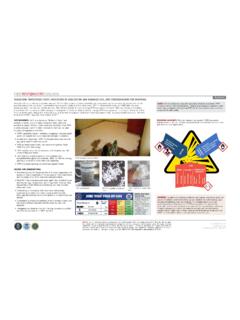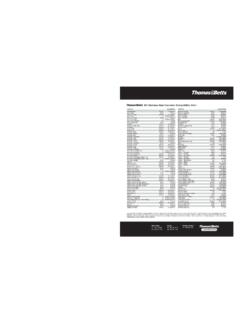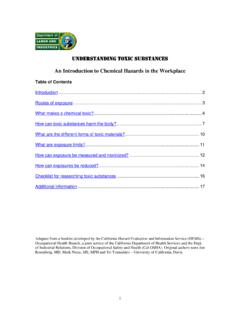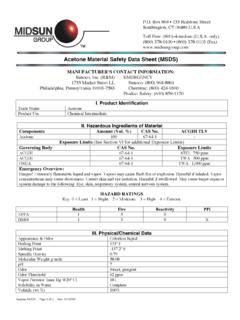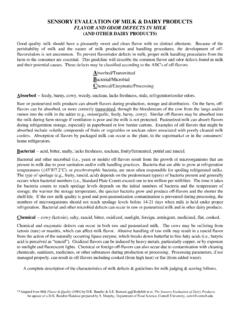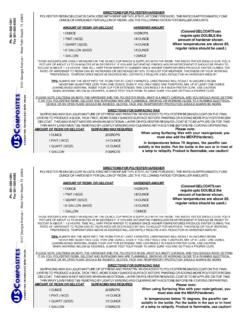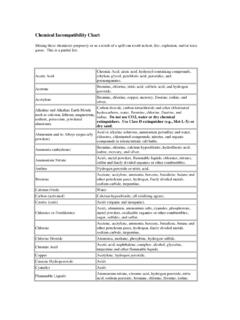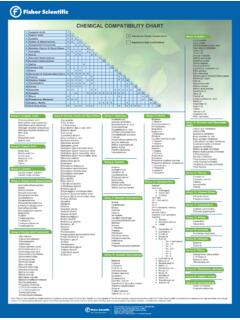Transcription of SAFETY DATA SHEET Acetone
1 SDS: Acetone LAST ISSUED: 11 December 2015 REVISION DATE: 28 November 2017 Rev 1 Page 1 of 8 SAFETY DATA SHEET Acetone SECTION 1: IDENTIFICATION OF material AND SUPPLIEREC TION Product Name: Acetone Other Names: 2-Propanone; Dimethyl Ketone Recommended Use: Solvent, Clensing product. Chemical raw material Applicable in: Australia Supplier: ACB Group (ABN 79 724 186 134) Address: 118 Swann Drive, Derrimut Victoria-3030 Telephone: + 61 3 93690220 Email Address: Facsimile: +61 3 93690883 Emergency Phone Number: 000 Fire Brigade and Police (available in Australia only). Poisons Information Centre: 13 11 26 (available in Australia only). 1: IDENTIFICATION OF THE material AND SUPPLIER This material SAFETY Data SHEET (SDS) is issued by the Supplier in accordance with National standards and guidelines from the Australian SAFETY and Compensation Council (ASCC, formerly National Occupational Health and SAFETY Commission - NOHSC).
2 The information in it must not be altered, deleted or added to. The Supplier will not accept any responsibility for any changes made to its SDS by any other person or organization. The Supplier will issue a new SDS when there is a change in product specifications and/or ASCC standards, codes, guidelines, or Regulations. S SECTION 2: HAZARD IDENTIFICATIONECTION 2: HAZARD IDENTIFICATION STATEMENT OF HAZARDOUS NATURE: Classified as Hazardous according to the criteria of the Australian SAFETY and Compensation Council ASCC (formerly NOHSC) Approved Criteria For Classifying Hazardous Substances [NOHSC:1008] 3rd Edition. Acetone is classified as Dangerous Goods according to the Australian Code for the Transport of Dangerous Goods by Road and Rail. GHS Classification: Flammable Liquid (category 2) Serious eye damage/ eye irritation (category 2A) Target Organ Systematic Toxicant Single Exposure (category 3) GHS LABEL ELEMENTS Symbol (s) Signal Word: Danger Hazard Statements: HAZARDS STATEMENT: H225: Flammable liquid and vapor H319: Causes serious eye irritation SDS: Acetone LAST ISSUED: 11 December 2015 REVISION DATE: 28 November 2017 Rev 1 Page 2 of 8 H336: May cause drowsiness and dizziness PRECAUTIONARY STATEMENT(s) Prevention Prevention P210: Keep away from heat/sparks/open flames/hot surfaces.
3 No Smoking. P233: Keep container tightly closed. P235: Keep cool P240: Ground/bond container and receiving equipment. P241: Use explosion-proof electrical/ventilating/lighting equipment. P242: Use only non-sparking tools. P243: Take precautionary measures against static discharge. P261: Avoid breathing dust/fume/gas/mist/vapors/spray. P264: Wash hands thoroughly after handling. P280: Wear protective gloves/protective clothing/eye protection/ face protection. P281: Use personal protective equipment as required. Response P303+P361+P353: IF ON SKIN (or hair): Remove/Take off immediately all contaminated clothing. Rinse skin with water/shower. Response P304+P340: IF INHALED: Remove to fresh air and keep at rest in a position comfortable for breathing. P305+P351+P353: IF IN EYES Rinse continuously with water for several minutes.
4 Remove contact lenses if present and easy to do. Continue rinsing. Immediately call a POISON CENTRE or doctor/physician. P312: Call a POISON CENTRE or doctor/physician if you feel unwell. P322: Specific measures (see details on this label). P321: Specific treatment (see details on label). P332+P313: If Skin irritation occurs. Get medical advice/attention. P337+P313: If eye irritation persists: Get medical advice/attention. P363: Wash contaminated clothing before reuse. P362: Take of contaminated clothing and wash before reuse. P370 +P378: In case of fire: Use appropriate media for extinction. Storage Disposal Disposal P501: Dispose of contents and container to appropriate waste site of reclaimer in accordance with local and national regulations. EC Hazards EUH066: Repeated exposure may cause skin dryness or cracking.
5 Other Hazards which do not result in classification None SECTION 3: COMPOSITION / INFORMATION ON INGREDIENTS Classification of components according to GHS Chemical name Synonyms CAS Hazard Class (Category) Hazard Statement Conc. Acetone ---- 67-64-1 Flam. Liq., 3 Eye irrit. 2A STOT SE., 3 H225 H319 H336 > %W SDS: Acetone LAST ISSUED: 11 December 2015 REVISION DATE: 28 November 2017 Rev 1 Page 3 of 8 SECTION 4: FIRST AID MEASURESEC Information: Consult a physician. Show this SAFETY data SHEET to the doctor in attendance Ingestion: Do NOT induce vomiting. Never give anything by mouth to an unconscious person. Rinse mouth with water. Consult a Eyes: Immediately flush eyes with large amounts of water for at least 15minutes while holding eyelids open.
6 Transport to the nearest medical facility for additional treatment. Skin: Remove contaminated clothing, wash off with plenty of water and soap. Consult a physician if any symptoms arise. Inhaled: Remove to fresh air. If rapid recovery does not occur, transport to nearest medical facility for additional treatment. First Aid Facilities: Eye wash fountains and SAFETY showers should be available for emergency use. Advice to Doctor: Most important symptoms and effects acute and delayed Immediate medical attention, special treatment The most important known symptoms and effects are described in the labelling and in section 11 cough, nausea, vomiting, headache, unconsciousness, shortness of breath, dizziness, narcosis. Lung oedema, central nervous system effects, Prolonged skin contact may degrease the skin and produce dermatitis.
7 SECTION 5: FIRE FIGHTING MEASURESE Specific Hazards: Under conditions giving incomplete combustion, hazardous gases produced may consist of: carbon monoxide (CO) carbon dioxide (CO2) Combustion gases of organic materials must in principle be graded as inhalation poisons Vapour is heavier than air and can travel considerable distance to a source of ignition and flashback Vapours may form explosive mixtures with air Suitable extinguishing media: Unsuitable extinguishing media Preferably; Alcohol resistant foam, water spray, polyvalent foam, BC powder, carbon dioxide. Do not use a solid water stream as it may scatter and spread fire. Special protective precautions and equipment for fire fighters: Other advice Wear full protective clothing and self-contained breathing apparatus. Cool containers / tanks with water spray.
8 Dike and collect water used to fight fire. Water run-off can cause environmental damage. Keep people away from and upwind of fire. ECTION 5: FIRE FIGHTING MEASURES SDS: Acetone LAST ISSUED: 11 December 2015 REVISION DATE: 28 November 2017 Rev 1 Page 4 of 8 SECTION 6: ACCIDENTAL RELEASE MEASURES Avoid contact with spilled or released material . For guidance on selection of personal protective equipment see chapter 8 of this material SAFETY Data SHEET . SECTION 6: ACCINTAL RELEASE Personal precautions, protective equipment and emergency procedures. Environmental procedures Methods and material for containment and cleaning up. Additional advice Use personal protective equipment. Avoid breathing vapours, mist or gas. Ensure adequate ventilation. Remove all sources of ignition.
9 Evacuate personnel to safe areas. Beware of vapours accumulating to form explosive concentrations. Vapours can accumulate in low areas. For personal protection see section 8. Prevent further leakage or spillage if safe to do so. Do not let product enter drains. Contain spillage, and then collect with an electrically protected vacuum cleaner or by wet brushing and place in container for disposal according to local regulations (see section 13). : Notify authorities if any exposure to the general public or the environment occurs or is likely to occur. Local authorities should be advised if significant spillages cannot be contained. The vapor is heavier than air, spreads along the ground and distant ignition is possible. See Chapter 13 for information on disposal. For guidance on selection of personal protective equipment see chapter 8 of this material SAFETY Data SHEET .
10 For guidance on disposal of spilled material see chapter 13 of this material SAFETY Data SHEET . SECTION 7: HANDLING AND STORAGEECTION 7: HANDLING AND Precautions for safe handling: Conditions for safe storage, including any incompatibilities Unsuitable material Suitable material Incompatible material Avoid contact with skin and eyes. Avoid inhalation of vapour or mist. Keep away from sources of ignition - No smoking .Take measures to prevent the build up of electrostatic charge. Refer to guidance under handling section. Store in cool place. Keep container tightly closed in a dry and well-ventilated place. Containers which are opened must be carefully resealed and kept upright to prevent leakage. Handle open containers with care. Synthetic material Oxidizing agents, reducing agents, (strong) acids, (strong) bases, halogens and amines.
